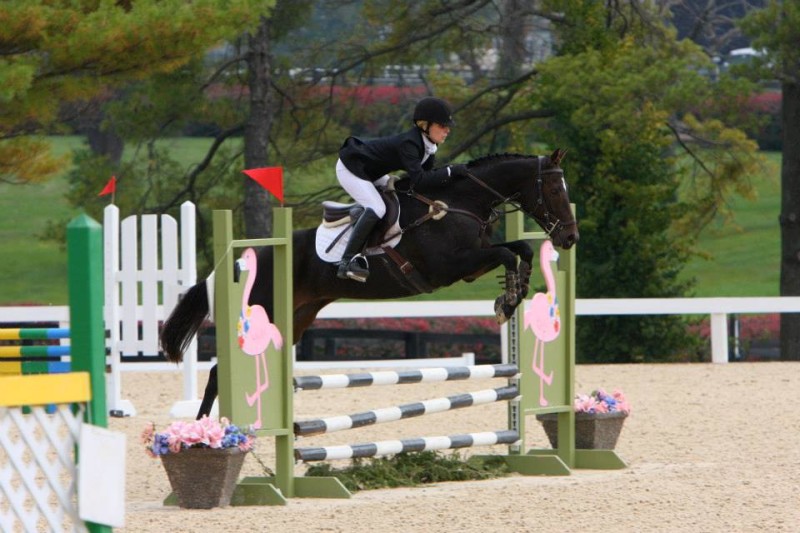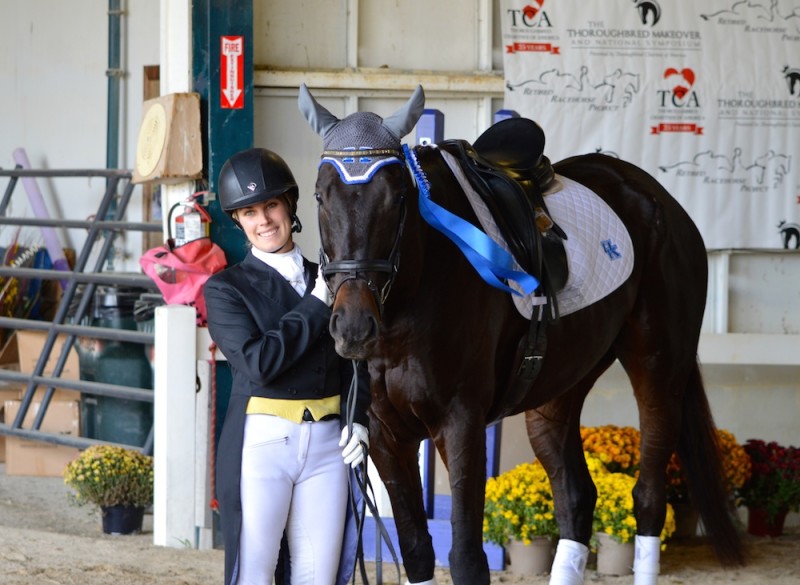As an entrant in the Retired Racehorse Project’s 2016 Thoroughbred Makeover I have joined a Facebook group for the competing trainers. While entries were finalized only a few weeks ago many trainers are already lamenting on their failures, setbacks and soundness issues. And yet, for every post about a failure, someone will post a photo of their horse at its first horse show, or jumping its first XC fence.
And so begins the comments…about rushing horses, pushing them too hard or overfacing them. It is a constant battle in our little equestrian community. Do we push horses too hard? Or do we not push them hard enough? Are you overfacing your horse, or dawdling away with your time? While not the perfect scenario, there are now numerous competitions based on a timeframe for the training scale. The RRP TB Makeover is just one.
And while all of these people are already panicking about their horses progress, I am sitting in Kentucky without a horse.
I am not worried about this major flaw in my plan for the 2016 RRP TB Makeover. I am not new to this retraining thing, and I am not worried because I know how different each horse comes to the training table. Some might be ready to be showcased in the makeover after only a few weeks, while others might not be ready after years. I have retrained enough ex-racehorses to acknowledge this. Yet, I will approach my horse shopping in the same manner that I always do: I will make sure that they are sound, of a certain frame, build and age, and pray to the Horse Gods that they have a good brain.
With my one-in/one-out horse sales policy, I can never take on numerous mounts. Exactly a year ago, on March 14th, 2015, I had just sold my previous retraining project. I was in the exact same spot—while many trainers were already panicked about their progress, I didn’t even have a horse in my barn. But like this year I wasn’t concerned, acknowledging that the RRP TB Makeover is just another day in the year and another opportunity to showcase the ability and beauty of the thoroughbred; something that I was already doing long before this particular show, and something that I will continue to do long after.
As surfed through photos of my previous sale horse Mason, I began to realize just how well he and my current sales horse Called to Serve (“Nixon”) oppose each other, and just how much they embody my rule of thumb to let the horse dictate the ride. Not a friend’s Facebook page nor fellow trainers’ show records. The horse.
It is a constant battle in our little equestrian community. Do we push horses too hard? Or do we not push them hard enough?
I got Cold as Stone (“Mason”) (Dehere – A Song in A Minor, 2010), at the end of August, 2014. He had been let down from the track and turned out for almost a year. He was sound and sturdy with good feet and a great brain.

Cold as Stone, aka “Mason”, the day I got him.
Mason turned out to be quirky but honest. He was talented and true but tended to overreact to many of the obstacles in his path. But he LOVED to jump. And because of this, as well as his soundness, we let him jump. It kept his brain happy, it kept our rides happy, and in exchange, he was able to be introduced into the world of competition rather quickly. Within a month of retraining he was at his first hunter pace, and within two months he ran his first unrecognized Beginner Novice HT, where he finished on his dressage score of 34.
Mason dictated his speed in training, and we listened. He was naturally elegant in the dressage, brave and careful in the jumping, and took to eventing rather quickly.

Maon jumping
More importantly, he was let down, sound and sane. I wasn’t fighting a tendon issue or dealing with a horse crashing off of a high sugar diet while attempting to teach him how to leg yield at the walk. He came to me ready for a new job and took to this new job like a fish out of water. He is still bravely moving forward in his training with his new trainer, and this makes me so happy.
Flash forward two months later, and Called to Serve (“Nixon”) was introduced to my life.

Called To Serve, aka “Nixon”
Nixon last raced at the end of March, 2015, and was let down for only two months. Like Mason, he also retired sound but had had a much more lengthy and legitimate race career. Where Mason had only raced 9 times, Nixon had raced 24. Where Mason had stayed in the states of Ohio and Kentucky, Nixon had travelled the world. And where Mason had barely hit the board in maiden claimers, Nixon was a Grade I placed, Grade III winner of almost $500,000. Nixon did not like letdown. Nixon craved a job and he was given to me at the end of May, 2015.
But unlike Mason, Nixon did not take to eventing like a fish out of water. I began my training in an almost identical fashion: plenty of hacking, lots of “little” obstacles and numerous field trips. However, where Mason took to jumping as if he had been doing it his entire life, Nixon took to it as a steeplechaser—the faster the better, and if that meant rails needed to be broken and his mom needed to pee her pants, well, so be it.

Photo by JJ Silliman
That’s why instead of pushing forward, I pulled back. Although in my heart and soul I knew he would eventually be a fantastic event horse, my brain told me that he wasn’t ready for it just yet. This was due to a combination of reasons: his brain, his speed and his heart. His athleticism was unregulated, having been allowed to get away with many bad habits at the track. And I don’t say this lightly, nor do I project this onto other racehorses. Mason had come to me with cadenced gaits and a student’s brain. But Nixon came to me with a reputation. There are stories on ESPN and The Daily Racing Form telling of him taking off with world class jockeys. There are stories of him racing without his tongue tie or noseband simply because he said “no”. These behaviors translated into our rides. He was the boss, I was a minion.
So we regrouped. We went back to the sandbox and began to work on things as simple as half halts. I wanted to be able to compress his gaits and obtain his attention. I wanted the rides to be a conversation, not a Donald Trump political rally.
Because of this, all of our “failures”, he had an almost unheard of progression in dressage, carrying us all the way to the winner’s circle of the 2015 RRP TB Makeover in the Dressage discipline.

Winner’s circle of the 2015 RRP TB Makeover
So this is where his training ended, right? No, of course not.
I knew all along our journey wasn’t complete with a single horse show. I also recognized that although he succeeded in dressage, I still believed he was meant for eventing. So after the Makeover, after we had built up his foundation on the flat, we went back to the drawing board in jumping.
Nixon began making great strides in his jumping last fall and this has carried over drastically through the winter and into this spring. He is now careful and scopey, brave but willing. And instead of dictating the ride he asks me for help, which I willingly offer. Our rides are a democracy, not a dictatorship.

Learning to respect fences…and me.
A good trainer finds the horses’s strengths and utilizes them to rebuild their weaknesses. They take their time. But time is relative. Time can mean one minute, or one life.
If you had asked me last summer how my training with him was going, I would have sighed and spoken of the failures, and how we were moving backwards instead of forwards, just like so many of these Facebook posts I read. I would have lamented his difficulties instead of acknowledging his abilities. He was already brave. He was already a beautiful mover. He was already sound. All I had to do was maintain those traits while building up his knowledge, adding to his skill set and entertaining his brain by introducing new concepts.
It might have taken longer than it did with Mason. It might have taken almost a year to get him to an event instead of a month. But does it matter? No. Why? Because I know they both eventually reached the same place. They are both competent, skilled, beautiful horses. There are no holes in their training, and no major flaws in their soundness. They both arrived at that place via different routes, but both routes brought them there.
That is what it what good training is all about. A good trainer doesn’t put a horse in a box. A good trainer doesn’t just succeed with a single type of horse. A good trainer finds the horses’s strengths and utilizes them to rebuild their weaknesses. They take their time. But time is relative. Time can mean one minute, or one life.
Let the horse be the clock. Let the horse turn the hands. It might feel like you are moving in slow motion, but the dials will still turn. And while it can feel like you are moving backwards, you are not, because let’s be honest, we really can only move in one direction—forward. So keep going. One foot in front of the other. Some of us might be walking, some of us running and some of us might be like Nixon—galloping straight through life. But, I promise you, we’ll all get to the finish line.
Read more at A Yankee in Paris.




 March 15, 2016
March 15, 2016 






















